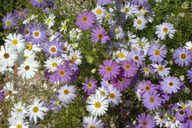In Flower This Week
A weekly news sheet prepared by a Gardens' volunteer.
Numbers before each plant refer to temporary IFTW labels in the gardens.
Numbers in square brackets [ ] refer to garden bed Sections. Plants in flower are in bold type.
View past issues of 'In Flower This Week'.
19 February 2014
Brachyscome iberidifolia click for larger image |
We will visit the Red Centre Garden [Section 326] today. This garden has only recently been opened and is still under development. All the plants in this section grow in the dry inland area of central Australia.
- As you enter the Red Centre Garden on the left is Solanum sturtianum, or Sturt’s Nightshade, with purple flowers with yellow anthers on an open bush of grey‑green foliage. The ripe fruit of this plant is reported to be toxic to stressed sheep and cattle.
- Further on your left is Calandrinia balonensis, or Broad-leaf Parakeelya, a low bush with purple flowers on wiry stems. Aboriginal people sometimes gathered the seeds and ground them into an edible paste. The common name Parakeelya, used for several species in the genus Calandrinia, is derived from one of the Aboriginal names for these plants.
- Bear left and on your right is Acacia kempeana, also called Witchetty Bush, a small bush with grey-green leaves and yellow rods of flower.
- On your left is Olearia stuartii, a small plant with mauve daisy flowers with yellow centres.
- Nicotiana rosulata subsp. ingulba, has a sharp scent, and white ‘tobacco’ flowers on lax foliage.
- Look to your right to see Gossypium sturtianum or Sturt’s Desert Rose, the floral emblem of the Northern Territory. It is a woody shrub with grey-green water-shedding leaves and glorious purple flowers with maroon centres.
- Hibbertia glaberrima on your left is a spreading shrub with bright yellow flowers.
- On your right is Cymbopogon obtectus, or Silky Heads. This aromatic grass has persistent shiny heads which make it look as though it has been touched with silver paint.
- On your left Rhodanthe floribunda forms small mounds covered in masses of white flowers with gold centres.
- On your right is Sida calyxhymenia, or Tall Sida, an erect grey-leaved bush with small pale yellow flowers.
- On the left are several bushes of Brachyscome iberidifolia, the Swan River Daisy, with ferny foliage and bright purple almost iridescent flowers.
- Swainsona formosa or Sturt’s Desert Pea, also on the left, is the iconic shiny red and black flower of central Australia pictured at the top of this sheet. It is the floral emblem of South Australia. Sturt's Desert Pea is protected in South Australia. The flowers and plants must not be collected on private land without the written consent of the owner. Collection on Crown land is illegal without a permit.
- Eremophila willsii subsp. integrifolia is a spindly shrub with mauve tubular flowers.
- On the right is Ptilotus nobilis subsp. nobilis with pale mauve feathery flowers on a neat small bush of hard leathery leaves.
- Rutidosis helichrysoides subsp. helichrysoides or Grey Wrinklewort is an erect branched herb with yellow globular heads of flower.
- Solanum orbiculatum subsp. orbiculatum on your left is a small, neat bush with purple ‘potato’ flowers.
Rosalind Walcott
![Director of National Parks [logo]](../../../../images/dnp_90px.gif)







